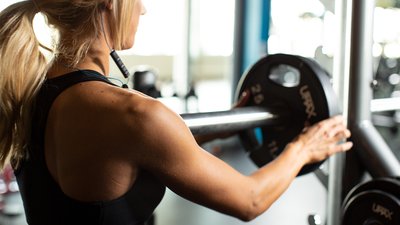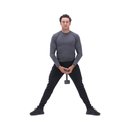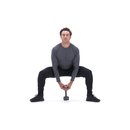The Question
There are many men and women over the age of 60 either trying to build up their physique or simply trying to be more active and healthy. In addition to maintaining or creating a great physique recovery and proper technique are now even more important.
What is the best workout for people over 60? Be specific.
How does a workout routine differ from someone who is over 60 compared to someone younger?
What are some good supplements for people over 60?
Show off your knowledge to the world!
The Winners
- soundcheck129 View Profile
- steveironpump View Profile
1st Place: soundcheck129
View This Author's BodySpace Here.
There are many men and women over the age of 60 either trying to build up their physique or simply trying to be more active and healthy. In addition to maintaining or creating a great physique recovery and proper technique are now even more important.
Exercise is important at any age, and staying active as one gets older is a great way to promote a healthier, longer life and prevent injuries. More and more older adults are engaging in a broad range of activities, from athletics to aerobics, proving that you don't have to be young to play hard and have fun.
What Is The Best Workout For People Over 60?
Obviously, older adults are going to engage in workouts that differ from those of younger adults and teenagers. While no one wants to be told that they can't do something, certain movements are inappropriate for older adults and age should be a consideration.
Before beginning a workout plan, it is important to consult a medical professional with a knowledge of your personal medical history—this advice goes for exercise enthusiasts of any age. But because older adults are at risk for more medical conditions, such as osteoporosis and arthritis, this is a crucial first step.
After gaining clearance, one may not be sure where to start. Thankfully, the ACSM has provided some general guidelines for exercise programs designed specifically for older adults.
The core recommendation is that at least 30 minutes of "moderate physical activity" should be performed on most days of the week. And while it may seem like an odd priority, strength training should be a main focus, as it prevents bone and muscle loss. Additionally, flexibility and functional movements (those that mimic everyday activities) are important.
In this example plan, there will be four days of cardiovascular activity and two days of strength training. If any discomfort or pain is felt during the activity, stop immediately and consult a trainer or medical professional for guidance. In addition, be sure to have water nearby at all times.
Cardiovascular Activity
Before beginning the session, it is imperative that one performs stretching as a warm-up. This reduces the risk of muscle strain and improves flexibility, a core concern of exercise programs for older adults. Remember not to "bounce" or stretch too far, as this will only aggravate the muscles. Some good stretches are: triceps stretch, seated floor twist, toe touch, standing biceps stretch, and the spinal stretch.
After stretching is complete, it's time to get the party started! For cardiovascular activity, the actual type of exercise isn't the most important thing, but rather the intensity level.
ACSM recommends working at a level that is "hard enough to raise your heart rate and break a sweat," but still allows one "to carry on a conversation." This ensures that the body is being stimulated but not so intensely that there is a risk of overexertion.
The options for activity are virtually limitless—do whatever you enjoy most. Because there are four cardiovascular days, variety can be incorporated—this is a nice way to keep things fresh and fun and prevent feeling burned out or bored. Some great activities for older adults are:
- Aerobics
- Swimming
- Walking
- Jogging
- Biking (indoors or outside)
- Aquatic Aerobics
- Step Aerobics
- Rowing Machine
All of these activities can be made more entertaining with the inclusion of family and friends, or if performed while reading a book or magazine or watching television. Before you know it, 30 minutes will have flown by.
Weight Training
Again, stretching is critical before beginning to exercise. Ensuring that joints and muscles are moving comfortably can avoid injury, and getting muscles warm before exercise leaves one less susceptible to strains. Weight training should be performed twice per week, in sessions lasting between 20 and 45 minutes. In addition, the same moderate level of intensity should be sought after.
Because hypertrophy and maximal force production are not likely to be goals for the 60 and up crowd, free weights and muscle specialization will not be necessary. Rather, one or two exercises should be performed for each of the following muscle groups: Legs, Back, Shoulders, Arms, Chest and Abdomen. For each exercise, two sets of 8-10 repetitions should be sufficient. In addition, the focus should be functional movements.
An example workout would look like this:

BodyFit
$6.99/month- 2,500+ expert-created single workouts
- 3,500+ how-to exercise videos
- Detailed workout instruction
- Step-by-step workout tips
- Training at gym or at home
- Access to Workout Plans
- Access to Bodyfit App
- Store Discounts
Already have a Bodybuilding.com account with BodyFit? Sign In

What comes with BodyFit?

- Instructional Videos
Don't risk doing a workout improperly! Avoid injury and keep your form in check with in-depth instructional videos.

- How-to Images
View our enormous library of workout photos and see exactly how each exercise should be done before you give it a shot.

- Step-by-Step Instructions
Quickly read through our step-by-step directions to ensure you're doing each workout correctly the first time, every time.
Click Here For A Printable Log Of soundcheck129's Day 1 Workout.
Day 2
- Push-ups: 2 sets of 8-15 reps
- Lat Pull-down: 2 sets of 8-10 reps
- Dumbbell Lunges: 2 sets of 8-10 reps (for both legs)
- Hyperextensions: 2 sets of 8-10 reps
- Abdominal Crunch Machine: 2 sets of 8-10 reps
- Seated Cable Row: 2 sets of 8-10 reps
- Leg Press: 2 sets of 8-10 reps
- Incline Chest Press: 2 sets of 8-10 reps
Click Here For A Printable Log Of soundcheck129's Day 2 Workout.
In order to prevent overexertion, weight training should not be performed on consecutive days. As with cardiovascular exercise, incorporating friends and family is a great way to make the experience more enjoyable, which increases the likelihood of continuation.
How Does A Workout Routine Differ From Someone Who Is Over 60?
Obviously, age makes a difference in terms of physical activity, especially in such a potentially demanding setting as the weight room. One major difference is in the frequency of workouts.
While teens may be able to handle three days of lifting per week with seven days of cardio, this is not realistic for older adults and would likely result in injury.
Duration of the workouts is different as well, with older adults exercising for about 1/3 to 1/2 of the length of time a younger athlete might. Intensity, too is different, as more tender joints and less conditioned lungs and other muscles are potential issues for older adults to consider.
The exercises themselves have a few differences. While free weights are often favored by serious gym-goers and exercise enthusiasts, machines are preferable for older adults.
The use of machines aids in maintaining proper form because the movement is assisted. Also, machine movements do not rely on stabilizing muscles as much, which is important as older adults may be somewhat deconditioned and will not have sufficiently developed muscles for complex free weight exercises.
Lastly, exercise selection for seniors is specialized. Functional movements are key, as are exercises that focus on more than one muscle. Because only a few lifts are being performed, isolation exercises would be inefficient and therefore inappropriate.
What Are Some Good Supplements For People Over 60?
Despite the fact that younger athletes should theoretically be healthier, the majority of supplements are targeted toward them. However, older adults may find many supplements suited to their needs. Some possibilities are:
Multivitamin
Multivitamins are recommended almost universally, and the over 60 crowd is no exception. Because older adults have lower calorie needs than younger athletes, they may find it difficult to derive adequate nutrition from their daily meals. A solid multivitamin will fill in the gaps and boost the immune system and overall health.
Fish Oil
Adequate intake of fatty acids is important to maintaining one's health, and a calorie-restricted diet may lack proper levels. Fats also cushion joints and organs, which are crucial considerations if one is living an active life. The consumption of healthy fats has also been linked to reductions in Alzheimer's disease and other mental disorders.[2]
Joint Care Supplement
Because properly functioning joints are imperative to movement, a joint care supplement is highly recommended. Older adults have had decades of wear and tear from gravity on their joints, so picking up glucosamine, a component of cartilage, would be a wise choice.
DHEA
This is a potent hormone that produces estrogen and testosterone. DHEA use is often said to "reduce the effects of aging" by boosting the immune system, contributing to development of muscle mass and improving memory. Who couldn't use a supplement like that?
Sources
- Physical Activity Guidelines. American College of Sports Medicine, 2007. http://www.acsm.org/
- The Human Brain - Fats. The Franklin Institute, 2004. http://www.fi.edu/learn/brain/fats.html#fatsbuild
2nd Place: steveironpump
View This Author's BodySpace Here.
Healthy Workout (Over 60)
At the age of 60, the body is mostly incapable of building large quantities of new muscle. For the most part, pre-existing muscle tissue may get larger, but the overall quantity will probably not increase. Recovery is also much slower due to reduced absorption rates of nutrients.
The body is also beginning to enter a fragile state in which joint related injuries are common and take a long time to recover from and many times, complete recovery is not possible. Any injury past the age of 60 is probably going to be pretty serious.
The main goal of working out should be to build some strength and reduce the risk for disease (primarily heart disease). Therefore, a workout should simply be to get the blood flowing and to build some strength without causing any serious injury in the process.
Workout Plan
The first step in creating a workout plan if you are over the age of 60 is to understand the condition of your body. A 60-year-old person who has been sedentary their whole life will obviously be in a different situation than a former marathon runner. It is also important to acknowledge any past injuries to the joints and to attempt to minimize the amount of stress being put on those joints.
Exercises to avoid:
- Dips*
- Bench Press*
- Free-Weight Squats
- Deadlifts
- Pulling or Pushing Movements Behind the Head*
- High Impact Cardio or Plyometrics
- High Risk For Shoulder Injuries
*High Risk For Shoulder Injuries.
The best overall workout would be a simple circuit-training routine that incorporates lifting movements that allow the weight to be easily controlled, which thus reduces the risk for injury.
The general format is to create a total body workout in which you move from one exercise to the next. High repetition exercises are also necessary to build strength while minimizing the risk for injury. Since this is a total body workout, try to focus on compound movements that involve many different body parts. Here's what a workout should look like:
- 5 minute low-intensity, low-impact cardio warm up. Use an elliptical, recumbent bike, or walk on a treadmill.
After warming up, start off your workout with a series of compound upper body movements. After that, move to a lower body movement, and then finish up with some core exercises.
The final part of the workout is to move back to the cardio machines to keep the blood flowing and the calories burning. 10-15 minutes of post-workout cardio is good enough. This cardio should be low to moderate intensity.
Here's the workout:
5-Minute Cardio Warm-Up
Upper Body
- Dumbbell Bench Press: (turn arms inward at the bottom of the movement) 10-20 reps
- Pull-Ups: 10-20 reps
- Triceps Extensions: 10-20 reps
- Dumbbell Biceps Curls: 10-20 reps
Note: Complete the cycle again only if you feel like you can handle it.
Click Here For A Printable Log Of steveironpump's Upper Body Workout.
Lower Body
- Leg Press: 10-20 reps
- Calf Press: 10-20 reps
- Leg Extensions: 10-20 reps
- Leg Curls: 10-20 reps
Note: Complete cycle again only if you feel like you can handle it.
Click Here For A Printable Log Of steveironpump's Lower Body Workout.
Core
- Exercise Ball Crunches: To failure
- Leg Raises: To failure
Note: Complete cycle again only if you feel like you can handle it.
Click Here For A Printable Log Of steveironpump's Core Workout.
Post-Workout Cardio
A workout should not last any longer than 45 minutes.
Only do one cycle the first time you workout to see where your conditioning. The average person will only be able to handle one cycle. If you absolutely run out of energy and you feel light-headed, then stop and let yourself recover. At that point, only continue if your body feels normal and regulated. Otherwise, call it a day and go home.
Try to workout 2 days a week and go walking on a few of the days in between workouts.
What Are Some Good Supplements For People Over 60?
Glucosamine, MSM, chondroitin, and collagen are all good supplements that will promote joint health. Anyone over the age of 60 should consume as many of these nutrients as possible to protect their joints. Some dietary supplements contain all four.
Make sure you are careful with working out, and don't push yourself if you experience pain in your joints or if you feel sick. At the age of 60, you want to get a good workout in while protecting your body at the same time.
Supplementing protein shakes is unnecessary and pointless. At this age, the body can't digest and absorb protein easily, which will result in excess bodily waste and weight gain from supplementation.




